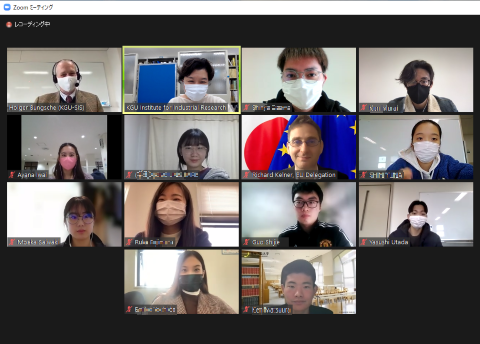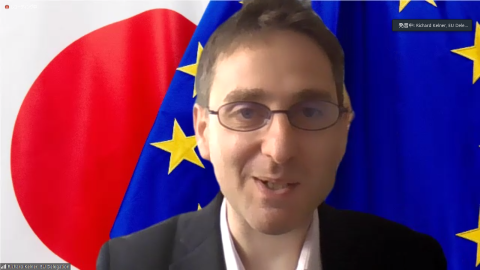- TOP
- Jean Monnet Activities
- Jean Monnet Chair (Agreement No. 2018・3245 / 004 – 001)
- EVENTS Jean Monnet Chair
- 10th December 2021 "Online Visit" to the Delegation of the European Union to Japan
[ Editor: Institute for Industrial Research 4th February, 2022]
10th December 2021 "Online Visit" to the Delegation of the European Union to Japan
Date & Time: 10th December 2021, 11:00 a.m. – 12:30 p.m.
Coordinator: Professor Holger Bungsche (School of International Studies, KGU)
Participants: 17
Topic: “The EU Climate Policy”
First Presentation: “Delivering the European Green Deal – The “Fit for 55” Package”
Presenter: Ms. Heidi Hiltunen (Trade Section)
Second Presentation: “Erasmus+ Chances for Japanese Students for Postgraduate Education”
Presenter: Mr. Richard Kelner (Political, Press and Information Section)
First Presentation: “Delivering the European Green Deal – The “Fit for 55” Package”
The first presentation was given by Ms. Heidi Hiltunen of the Trade Section, where she works on the topic of climate policies, as well as in related fields like transport and energy policies.
At first Ms. Hiltunen explained the “European Green Deal”, which, introduced in 2019, is basically the EU’s new growth strategy aiming at cutting greenhouse gas emissions while at the same time sustaining economic growth and creating new high qualified, high paid jobs in Europe. The “European Green Deal” is designed to lead the EU into an ecological transition towards a modern, resource-efficient and competitive industrial development, for the first time decoupling economic growth from resource/energy use and pollution. In this way it is about creating jobs, increasing competitiveness and boosting innovation.
Next, Ms. Hiltunen pointed to implementation of measures in order to achieve this transformation of the European economy stressing in particular the need for the implementation of measures that are cutting across policy areas from energy and mobility, environment and bio-diversity to agriculture and R&D activities. She also emphasized that this transformation has to be a Just Transformation, which does not leave anyone behind. Briefly touching upon the climate targets of the EU until 2030 and 2050 and the major decisions that have been taken so far to reach these targets, Ms. Hiltunen introduced the results of an impact assessment report the EU has conducted and stressed in particular the need for long-term, reliable legislation, which is needed to give the private sector planning certainty which only will make the private sector to invest in new technologies.

To make the topic easier to grasp, Ms. Hiltunen gave three practical examples of actual EU policies. First the Hydrogen Strategy the EU adopted in July 2020, which in three implementation phases until 2024, between 2024 and 2030, and beyond 2030, is aiming at boosting Clean Hydrogen Energy particular in sectors that are perceived to be hard-to-decarbonize. The second example was the efforts to renovate the building stock in Europe, which is quite old. Private houses are consuming 40% of all energy and emitting 36% of all greenhouse gases in the EU. The aim is to renovate 35 million buildings in Europe, by that creating 160,000 additional green jobs in the construction sector. The last example was the EU Strategy on Offshore Renewable Energy. With this respect in particular the high potential of still emerging technologies in this area like “floating wind” and the necessity to get large parts of the population behind these efforts were stressed.
Next, with regard to the current initiatives on the EU level to pursue the needed transformational change of the EU economy, Ms. Hiltunen introduced “Fit for 55” package to reach the target of 55% reduction in greenhouse gas emissions until 2030. This “Fit for 55” package is not only designed to achieve the change in a fair, cost-efficient and competitive way, but is also aiming at providing countries worldwide with a feasible guideline of how to achieve their own climate target goals. Without going into certain areas and sectors in particular, the presentation in this part focused on the mix of various policies aiming at striking a careful balance between pricing, targets, standards, rules and other measures by briefly explaining the new EU Emission Trading System, that not only includes the large industrial installations and energy producers, but recently also aviation, road transport, buildings and maritime emissions.
With regard to the Emission Trading System Ms. Hiltunen extended her talk to the controversial “Carbon Boarder Adjustment Mechanism”, which is designed to protect producers and other economic actors in the EU, who have to follow stricter EU regulations from competition from non-EU countries that apply looser, less strict regulations. The mechanism is also intended to reduce the incentives for EU producers to move production outside to the EU to countries with lower carbon emission standards (carbon leakage). The difficulty in implementing this mechanism is, first, that it has to be compatible with WTO rules and, second, that it must be made sure that imported products from outside the EU that are produced under comparable regulations are exempted from the adjustment mechanism.
Another legislative initiative currently under discussion is the revision of the Renewable Energy Directive that intends to increase the target of renewable energies in the EU energy mix for the year 2030 from its original 32% to 40%. The current share of renewables (2020) is roughly 20%. In particular the aim is to increase the share of renewables in key sectors like heating and cooling, buildings, transport and industry. In line with the Renewable Energy Directive also the Energy Efficiency Directive is currently under revision.
Finally, current policy measures affecting the transport sector were briefly outlined. Emissions of the transport sector have to be reduced by 90% until 2050.
The presentation provoked numerous questions from the participating students, which indicated that the presentation met the interest of the students very well.

Second Presentation: “Erasmus+ Chances for Japanese Students for Postgraduate Education”
As it has already become a sort of good tradition, in the second presentation Mr. Richard Kelner, Academic Cooperation Officer of the Political, Press and Information Section, introduced the various opportunities the EU provides in particular also for students from Japan to study in the EU.
As in the previous two years the focus of Mr. Kelner’s presentation was on the Erasmus+ Program and its many courses that it is offering to students worldwide. Particularly after two years of travel restrictions due to COVID-19, the Erasmus+ Program is even more attractive than ever before, because it is basically designed as a multi-country program, where participating students in general study at different universities during their two years of graduate studies in Europe. Not just explaining the program in general terms, Mr. Kelner also gave specific information on how to apply and where to gather additional information. Last but not least Mr. Kelner made students aware of the “Study in Europe Fair”, which the EU Delegation has been organizing regularly every year at different locations in Japan until 2019 when the Fair had to go online due to the restrictions in reaction to the COVID-19 pandemic.


